Dynamic Modeling and Vibration Characteristics for a High-Speed Aero-Engine Rotor with Blade Off
Abstract
:1. Introduction
2. Mathematical Model
2.1. Mechanical Characteristics and Sudden Unbalance Excitation Caused by Blade Off
2.1.1. Sudden Unbalance Excitation
2.1.2. Inertial Asymmetry of the Blade-Disk System
2.2. The Motion Governing Equation of Gas Turbine Rotor with Blade off
3. Modeling Method Validation through a Test Rotor
4. Numerical Results and Discussion
4.1. Critical Speeds and Mode Shapes
4.2. Evolution of Transient Dynamic Response of Blade off
4.2.1. Time-Domain Response Characteristics
4.2.2. Transient Orbit Characteristics
4.2.3. Frequency-Domain Response Characteristics
4.2.4. Impact Effect Due to Sudden Unbalance
4.3. Parametric Analysis
4.3.1. Influence of Rotational Speed
4.3.2. Influence of Blade off Location
4.4. Comparison of Simulation and Test Data
5. Conclusions
- (1)
- The validity of the rotor modeling method is verified by a test. The proposed dynamic model can reflect the dynamic characteristics of the complicated rotor well. It is suitable for vibration analysis because the complex rotor structure is characterized with fewer degrees of freedom. Based on the dynamic model established, the natural characteristics and transient response evolution, including the time-domain, frequency-domain, and orbit, of a high-speed gas generator rotor with blade off are revealed.
- (2)
- The impact effect due to blade off has time-dependent and location-dependent characteristics. When the blade off occurs, the amplitude of transient response increases suddenly and reaches to a peak point soon and then oscillates downward to a stable value with several revolutions. The instantaneous impact force due to blade off is the fundamental reason for the sharp increase in vibration response, and the generated large unbalance after blade off and system damping are the reason for the finally stable amplitude reached. The blade off excites some lower-order natural modes, such that the transient response contains some lower natural frequency components.
- (3)
- The responses of the rotor with blade off occurring at different rotational speeds have similar characteristics, while the rotational speed has a significant influence on the impact factor, i.e., the higher the speed, the greater the impact factor.
- (4)
- The parameter of the blade off location will not only have a significant effect on the impact factor, but also on the frequency spectrum characteristics at each node of the rotor. The transient response excited by the blade off of 1AC is greater than that caused by the loss of the 1GT blade. The sudden unbalance excitation at 1AC can excite the first three-order natural modes simultaneously (fn1, fn2−, fn2+, fn3−, fn3+), while the excitation at 1GT can only excite the first two modes (fn1, fn2−, fn2+).
- (5)
- When blade off occurs at 1AC, 1# bearing and its supporting structure are most likely to be damaged and some safety design needs to be adopted because it has the largest transient and steady-state amplitude and a high impact factor.
- (6)
- The above-mentioned transient response time series, frequency spectrum difference, and impact factor distribution characteristics between two blade off cases can provide a good theoretical basis for the fault recognition of these complex rotors suffering from blade off. At the same time, the modeling method can be applied to other types of rotors.
Author Contributions
Funding
Institutional Review Board Statement
Informed Consent Statement
Data Availability Statement
Conflicts of Interest
References
- Wang, N.; Liu, C.; Jiang, D. Prediction of transient vibration response of dual-rotor-blade-casing system with blade off. Proc. Inst. Mech. Eng. Part G J. Aerosp. Eng. 2019, 233, 5164–5176. [Google Scholar] [CrossRef]
- Heidari, M.; Carlson, D.; Sinha, S.; Sadeghi, R.; Heydari, C.; Bayoumi, H.; Son, J. An Efficient Multi-Disciplinary Simulation of Engine Fan-Blade Out Event Using MD Nastran. In Proceedings of the 49th AIAA/ASME/ASCE/AHS/ASC Structures, Structural Dynamics, and Materials Conference; Multidisciplinary Design Optimization Specialists Conference, Schaumburg, IL, USA, 7 April 2008; 2008. [Google Scholar] [CrossRef]
- Yu, P.; Zhang, D.; Ma, Y.; Hong, J. Dynamic modeling and vibration characteristics analysis of the aero-engine dual-rotor system with Fan blade out. Mech. Syst. Signal Process. 2018, 106, 158–175. [Google Scholar] [CrossRef]
- Chen, G.; Hong, J.; Ma, Y.H. Aviation gas turbine engine structure; Beihang University Press: Beijing, China, 2010. [Google Scholar]
- Wang, Z.Y.; Gong, B.; Wen, B.C. Research on rotor dynamics with sudden change of mass and excitation magnitude. J. Vib. Shock. 2008, 27, 48–51. [Google Scholar]
- Kalinowski, P.; Bargen, O.V.; Liebich, R. Vibrations of rotating machinery due to sudden mass loss. In Proceedings of the 8th IFToMM International Conference on Rotor Dynamics, Seoul, Korea, 12–15 September 2010; pp. 584–590. [Google Scholar]
- Genta, G. Dynamics of Rotating Systems; Springer Science & Business Media: Berlin/Heidelberg, Germany, 2007. [Google Scholar]
- Wang, C.; Zhang, D.; Ma, Y.; Liang, Z.; Hong, J. Dynamic behavior of aero-engine rotor with fusing design suffering blade off. Chin. J. Aeronaut. 2017, 30, 918–931. [Google Scholar] [CrossRef]
- Wang, C.; Zhang, D.; Ma, Y.; Liang, Z.; Hong, J. Theoretical and experimental investigation on the sudden unbalance and rub-impact in rotor system caused by blade off. Mech. Syst. Signal Process. 2016, 76-77, 111–135. [Google Scholar] [CrossRef]
- Li, T.; Ren, X.M.; Yue, C. Transient response of single-disc rotor system under sudden unbalance. Mech. Sci. Technol. Aerosp. Eng. 2012, 31, 924–927. [Google Scholar]
- Sinha, S.K. Rotordynamic analysis of asymmetric turbofan rotor due to fan blade-loss event with contact impact rub loads. J. Sound. Vib. 2013, 332, 2253–2283. [Google Scholar] [CrossRef] [Green Version]
- Sinha, S.K.; Dorbala, S. Dynamic Loads in the Fan Containment Structure of a Turbofan Engine. J. Aerosp. Eng. 2009, 22, 260–269. [Google Scholar] [CrossRef]
- Wei, J.; Bai, P.; Qin, D.; Lim, T.C.; Yang, P.; Zhang, H. Study on Vibration Characteristics of Fan Shaft of Geared Turbofan Engine with Sudden Imbalance Caused by Blade Off. J. Vib. Acoust. 2018, 140, 041010. [Google Scholar] [CrossRef]
- Hong, J.; Li, T.R.; Wang, Y.F.; Hong, J. Dynamic response of the aero-engine flexible rotor system under the blade-off. J. Aerosp. Power 2018, 33, 257–264. [Google Scholar]
- Bin, G.F.; Liao, Z.H.; Yao, J.F.; Guo, S.P. Study on blade loss vibration characteristics for low pressure rotor of 600 MW supercritical steam turbine generator units. Lubr. Eng. 2017, 42, 72–78. [Google Scholar]
- Li, C.; Liu, D.; Ma, Y.H.; Hong, J. Dynamic characteristics of rotor and safety design of support structure with fan blade off. J. Aerosp. Power 2020, 35, 2263–2274. [Google Scholar]
- Wang, L.K.; Wang, A.L.; Jin, M.; Yin, Y.J. Bistable vibration characteristics of rod fastening rotor with internal damping. China Mech. Eng. 2021, 32, 512–522, 564. [Google Scholar]
- Wang, L.K.; Wang, A.L.; Jin, M.; Huang, Q.K.; Yin, Y.J. Nonlinear effects of induced unbalance in the rod fastening rotor-bearing system considering nonlinear contact. Arch. Appl. Mech. 2020, 90, 917–943. [Google Scholar] [CrossRef]
- Wang, L.K.; Wang, A.L.; Jin, M.; Yin, Y.J.; Heng, X.; Ma, P.W. Nonlinear dynamic response and stability of a rod fastening rotor with internal damping effect. Arch. Appl. Mech. 2021, 91, 3851–3867. [Google Scholar] [CrossRef]
- Wang, N.F.; Liu, C.; Jiang, D.X.; Behdinan, K. Casing vibration response prediction of dual-rotor-blade-casing system with blade-casing rubbing. Mech. Syst. Signal Process. 2019, 118, 61–77. [Google Scholar] [CrossRef]
- Mercorelli, P. Denoising and harmonic detection using nonorthogonal wavelet packets in industrial applications. J. Syst. Sci. Complex. 2007, 20, 325–343. [Google Scholar] [CrossRef]
- Mercorelli, P. Biorthogonal wavelet trees in the classification of embedded signal classes for intelligent sensors using machine learning applications. J. Frankl. Inst. 2007, 344, 813–829. [Google Scholar] [CrossRef]
- Schimmack, M.; Mercorelli, P. A structural property of the wavelet packet transform method to localise incoherency of a signal. J. Frankl. Inst. 2019, 356, 10123–10137. [Google Scholar] [CrossRef]
- Schimmack, M.; Mercorelli, P. An on-line orthogonal wavelet denoising algorithm for high-resolution surface scans. J. Frankl. Inst. 2018, 355, 9245–9270. [Google Scholar] [CrossRef]
- Lei, B.L.; Li, C.; He, K.; Ma, Y.H.; Hong, J. Coupling vibration characteristics analysis and experiment of shared support-rotors system. J. Aerosp. Power 2020, 35, 2293–2305. [Google Scholar]
- Zhang, J.; Zhang, D.Y.; Wang, Y.F.; Ma, Y.H.; Hong, J. Coupling vibration characteristics analysis of shared support-rotors system. J. Beijing Univ. Aeronaut. Astronaut. 2019, 45, 1902–1910. [Google Scholar]
- Liao, Z.H.; Bin, G.F.; Li, C.; Yuan, W. Design method of the simulated-rotor test rig for the turboshaft engine based on the critical speed and the similarity of vibration mode. J. Mach. Des. 2021, 38, 45–50. [Google Scholar]
- Deng, W.Q.; Wu, S.Z.; Liu, W.K.; Sun, Y.; Tang, H.B. Support stiffness modification method for a high-speed rotor with flexible stator. J. Vib. Shock. 2020, 39, 29–35, 66. [Google Scholar]
- Ma, Y.H.; He, T.Y.; Zhang, D.Y.; Hong, J. Imbalance response of rotor system with nonlinear bearing stiffness. J. Aerosp. Power 2014, 29, 1527–1534. [Google Scholar]
- Hai, P.M.; Bonello, P. An Impulsive Receptance technique for the time domain computation of the vibration of a whole aero-engine model with nonlinear bearings. J. Sound Vib. 2008, 318, 592–605. [Google Scholar] [CrossRef]
- Yang, X.G.; Luo, G.H.; Wen, W.D.; Tang, Z.H.; Wang, F. Impacts of support’s nonlinear characteristics on response characteristics of dual-rotor system. J. Vib. Eng. 2014, 27, 572–582. [Google Scholar]
- Meng, C.; Su, M.; Wang, S.B. An Investigation on dynamic characteristics of a gas turbine rotor using an improved transfer matrix method. J. Eng. Gas Turbines Power 2013, 135, 122505. [Google Scholar] [CrossRef]
- Wang, L.K.; Bin, G.F.; Li, X.J.; Zhang, X.F. Effects of floating ring bearing manufacturing tolerance clearances on the dynamic characteristics for turbocharger. Chin. J. Mech. Eng. 2015, 28, 530–540. [Google Scholar] [CrossRef]
- Zhong, Y.E.; He, Y.Z.; Wang, Z.; Li, F.Z. Rotor Dynamics; Tsinghua University Press: Beijing, China, 1987. [Google Scholar]
- Ma, H.; Li, H.; Zhao, X.; Niu, H.; Wen, B. Effects of eccentric phase difference between two discs on oil-film instability in a rotor–bearing system. Mech. Syst. Signal Process. 2013, 41, 526–545. [Google Scholar] [CrossRef]
- Nelson, H.D. A finite rotating shaft element using Timoshenko beam theory. J. Mech. Des. 1980, 102, 793–803. [Google Scholar] [CrossRef]
- Wang, L.; Bin, G.; Li, X.; Liu, D. Effects of unbalance location on dynamic characteristics of high-speed gasoline engine turbocharger with floating ring bearings. Chin. J. Mech. Eng. 2016, 29, 271–280. [Google Scholar] [CrossRef]
- Li, Y.; Luo, Z.; Liu, J.; Ma, H.; Yang, D. Dynamic modeling and stability analysis of a rotor-bearing system with bolted-disk joint. Mech. Syst. Signal Process. 2021, 158, 107778. [Google Scholar] [CrossRef]

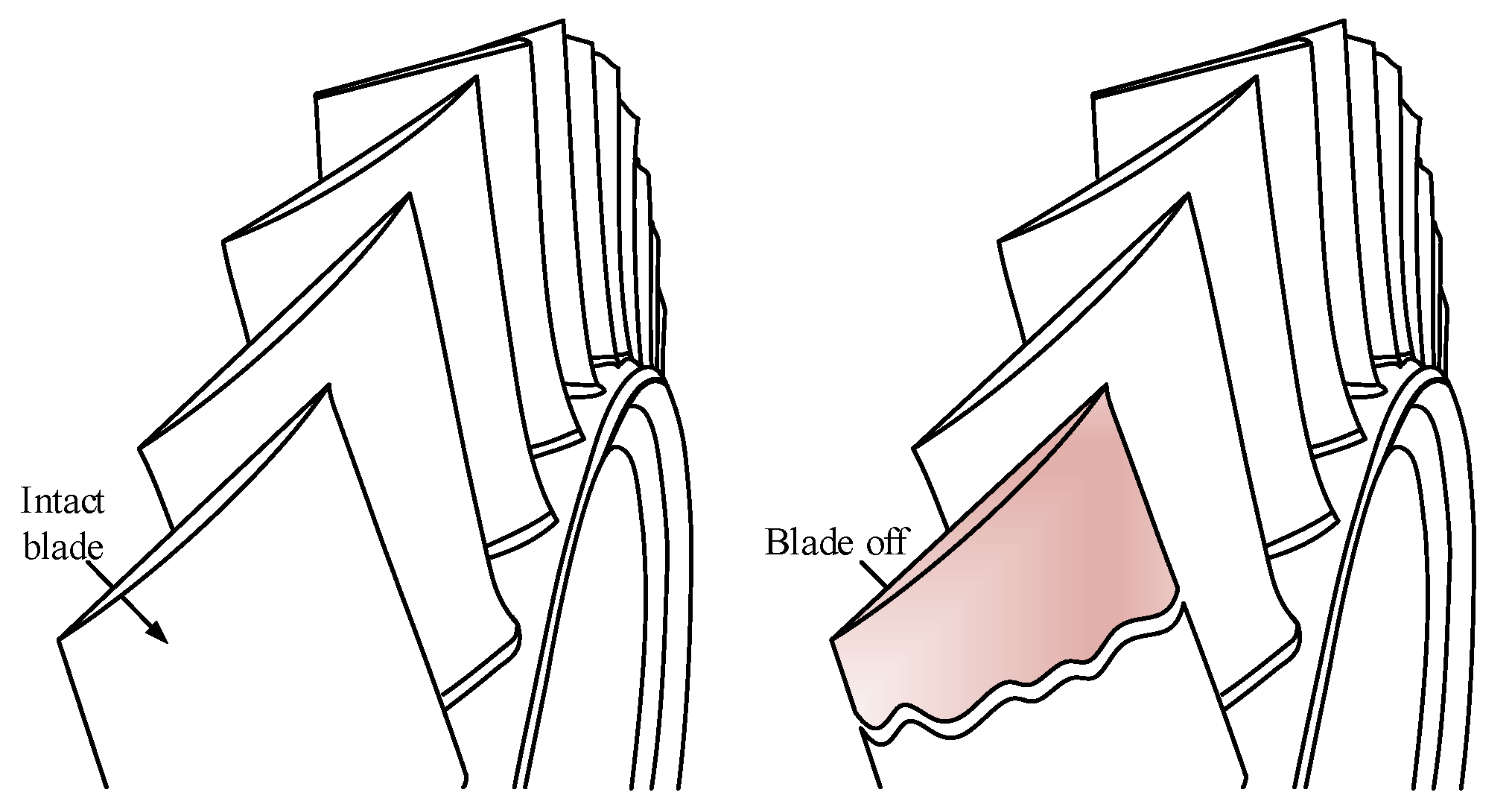

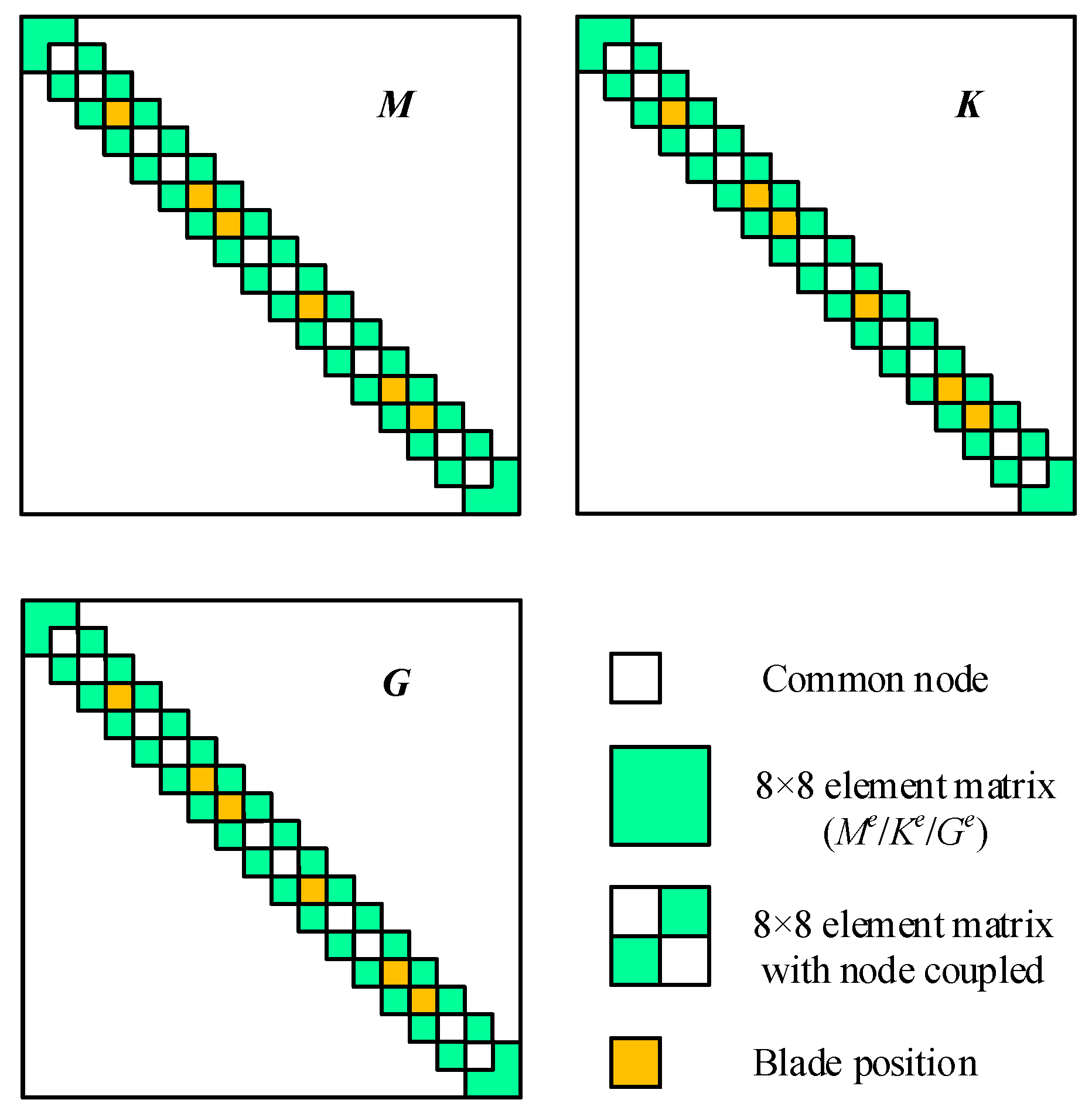
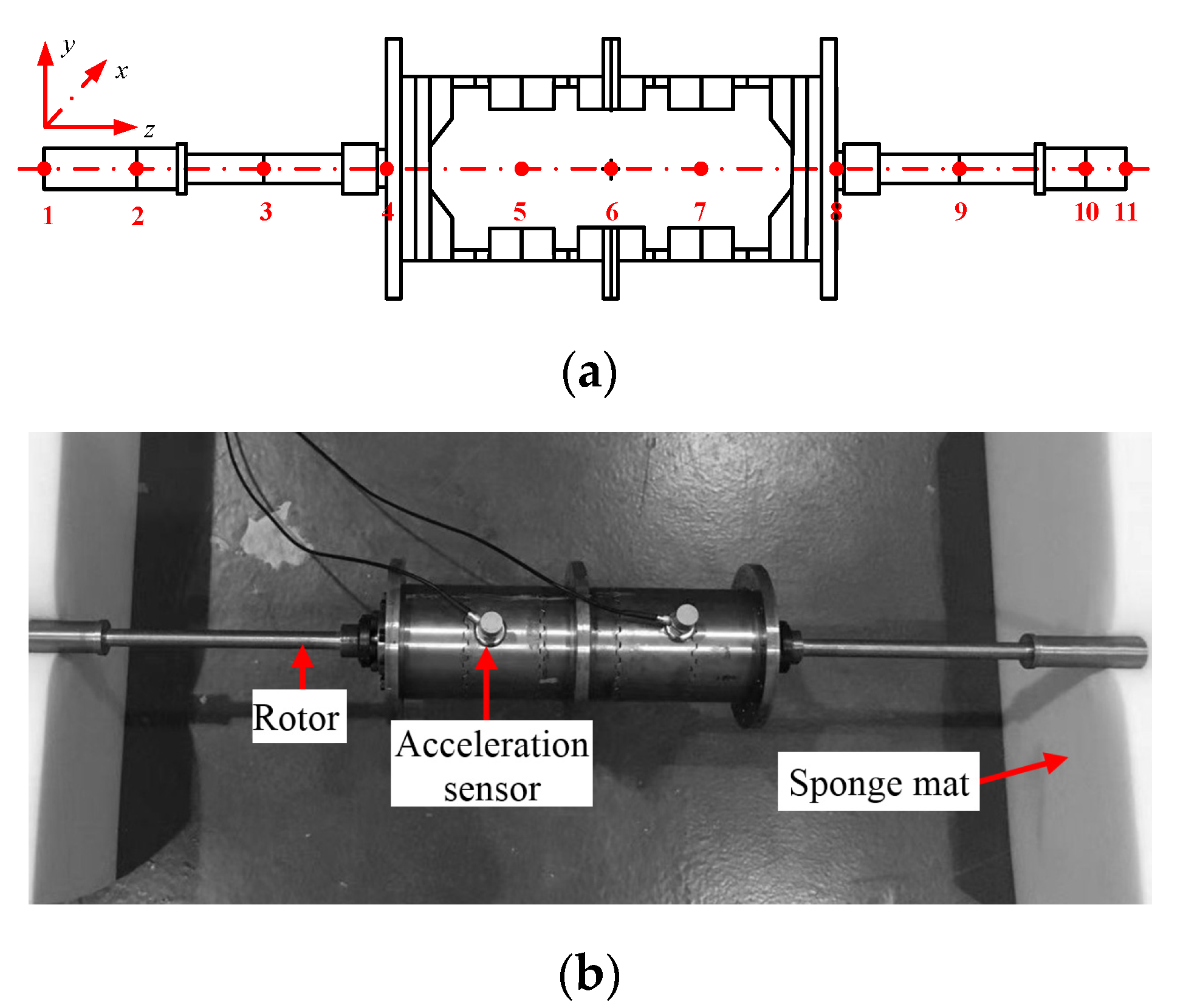
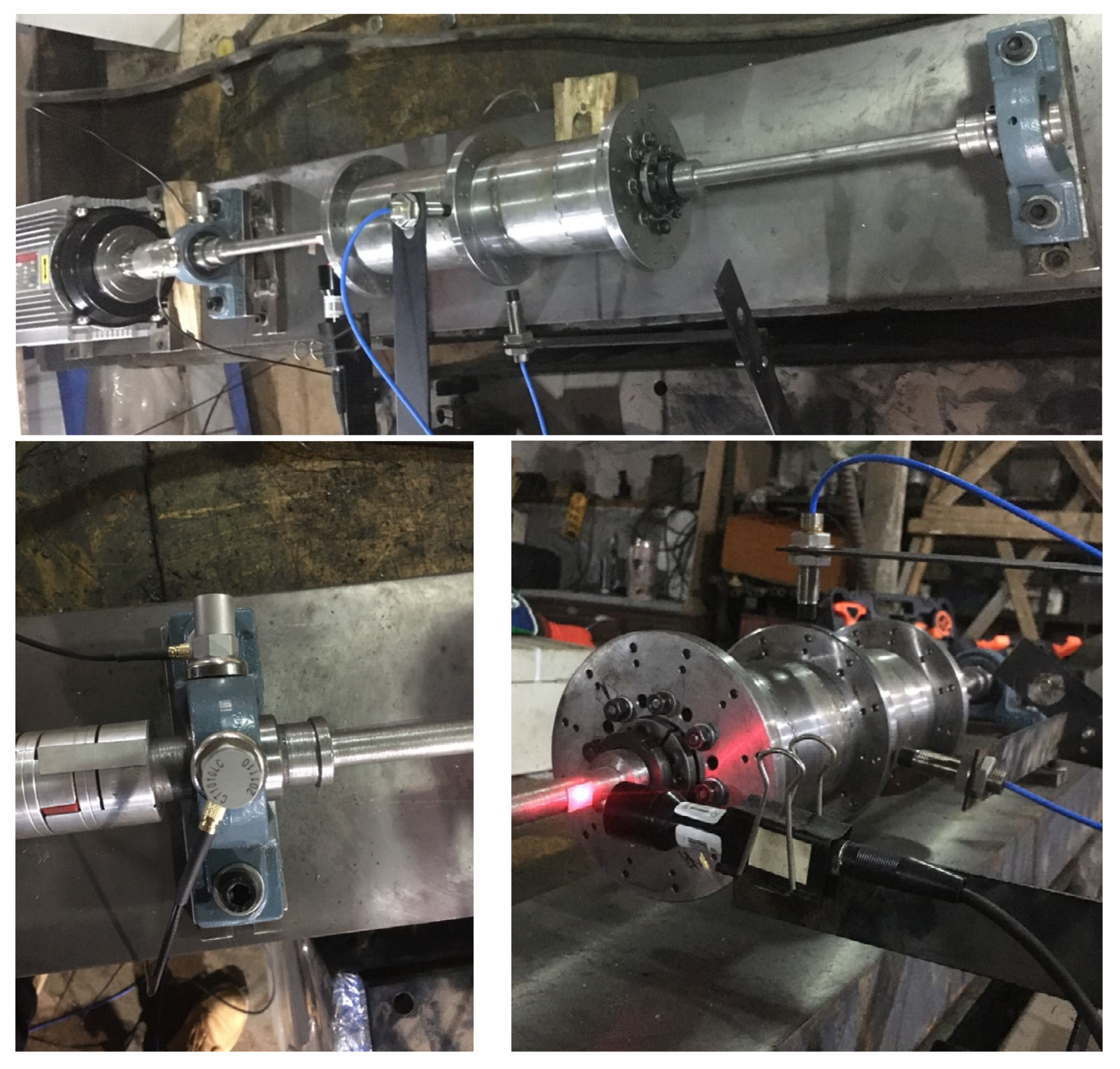
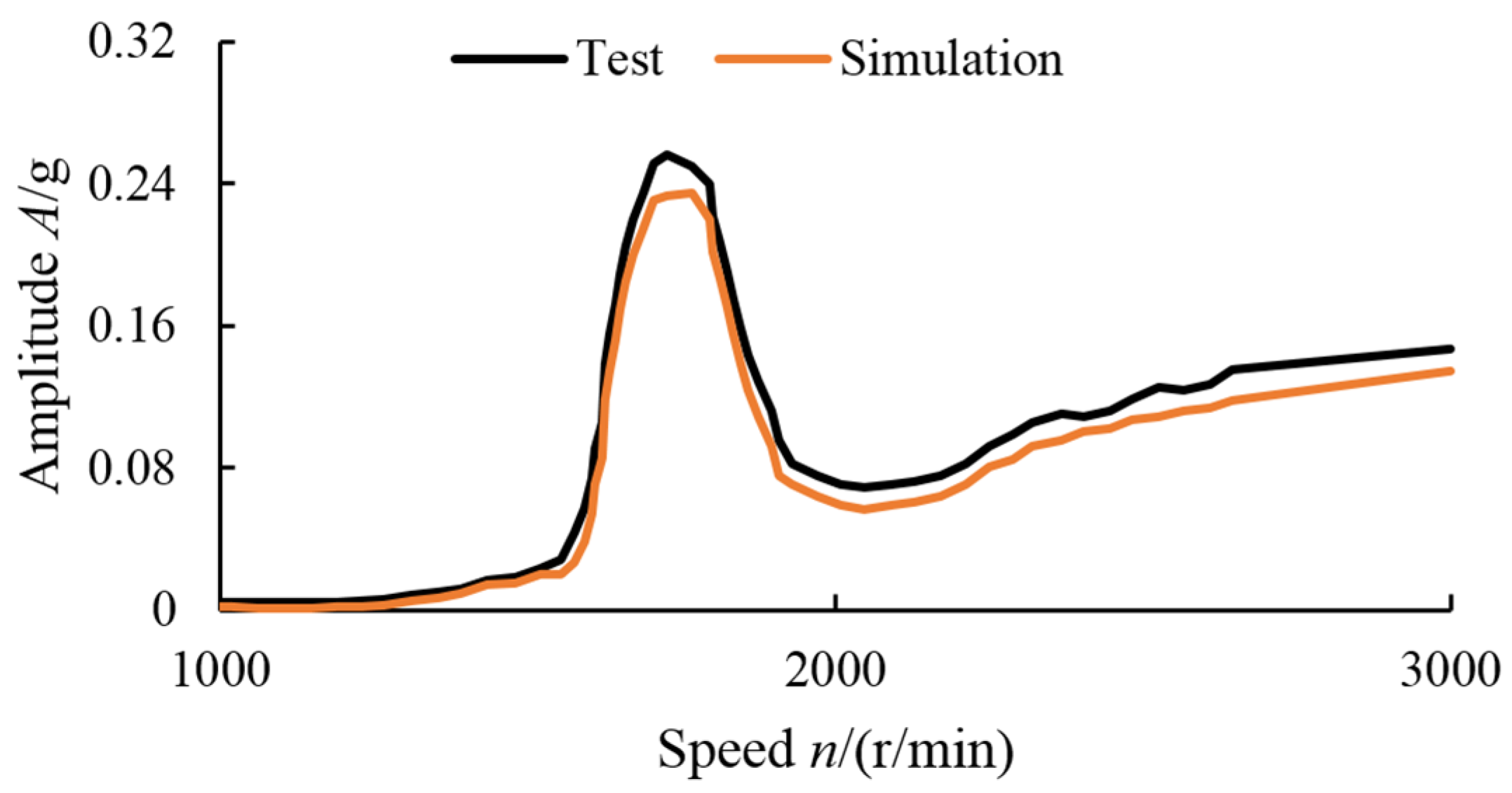


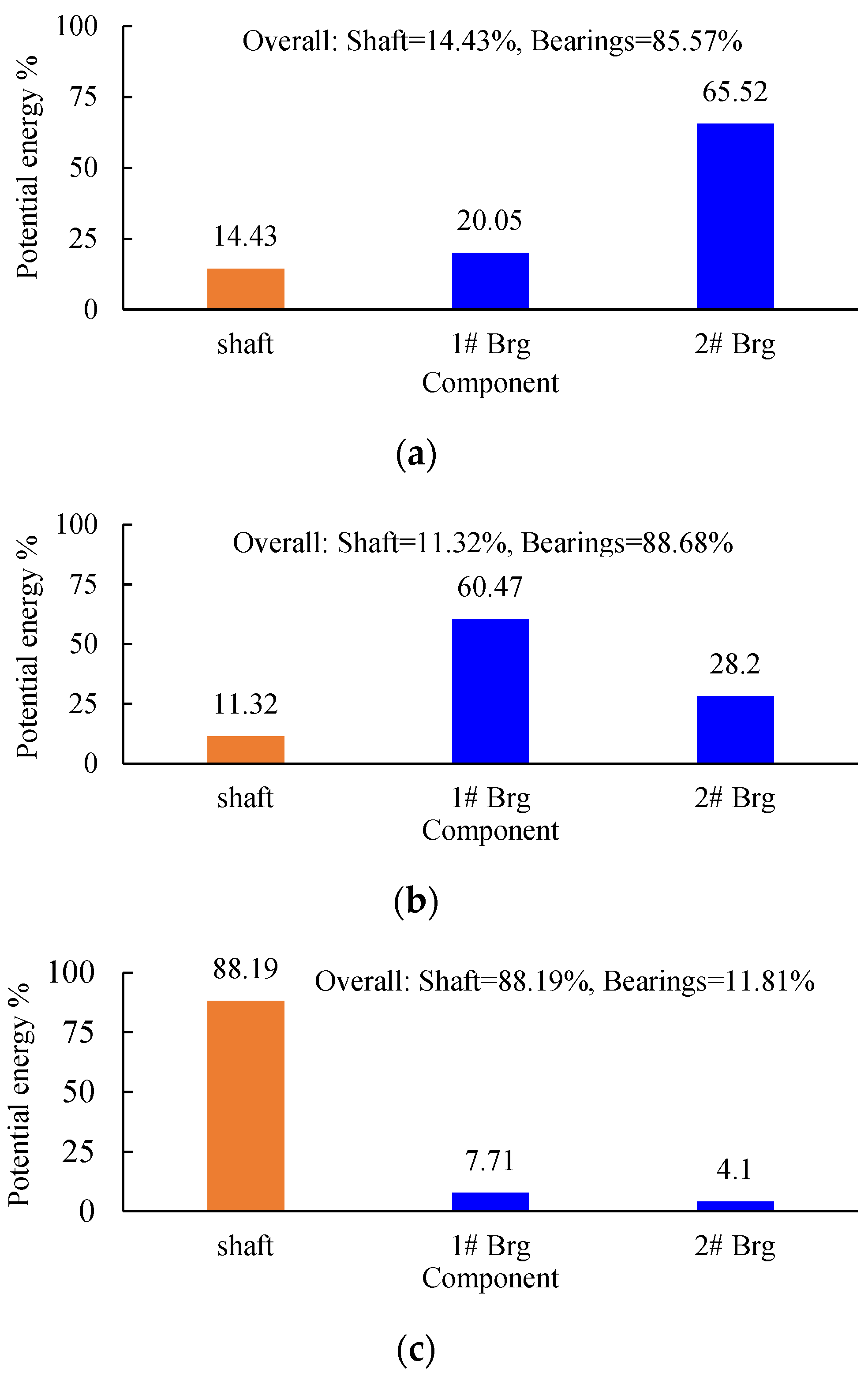

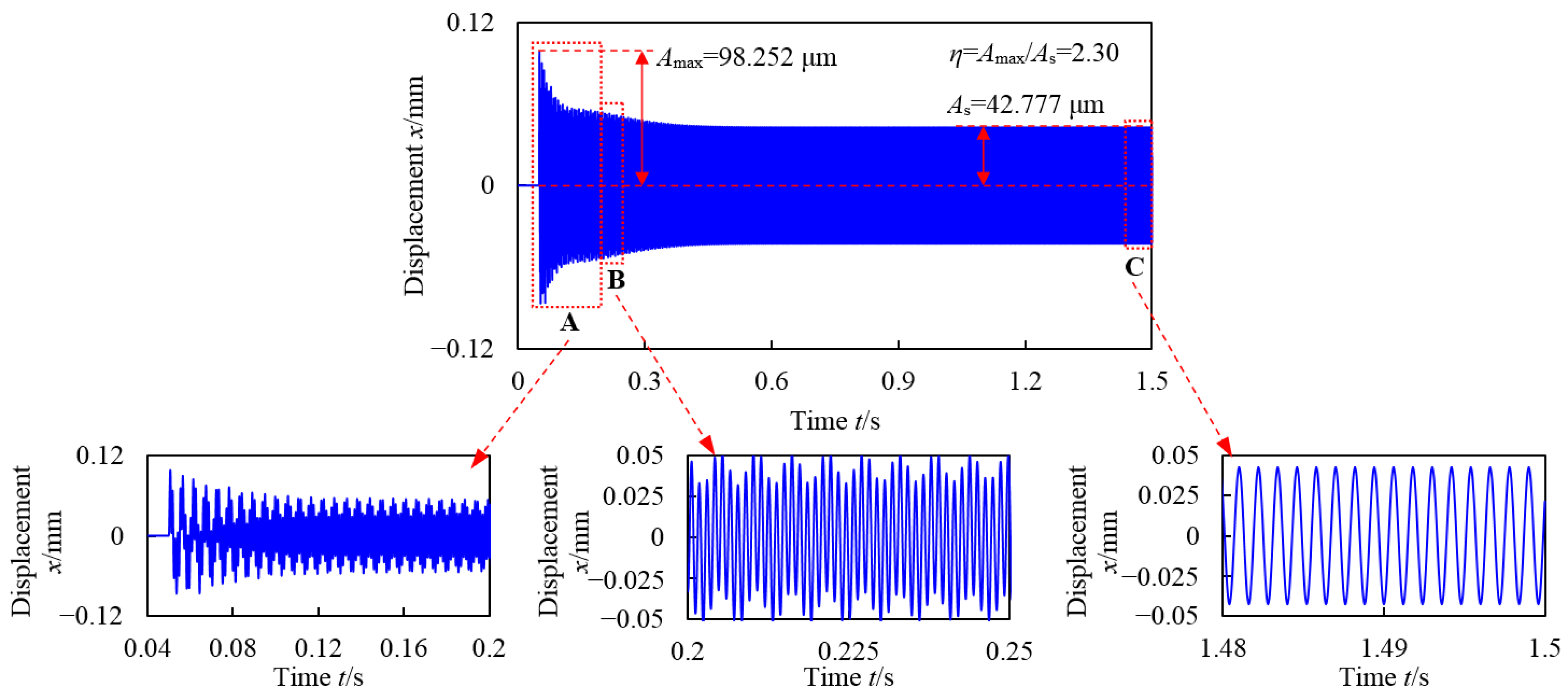
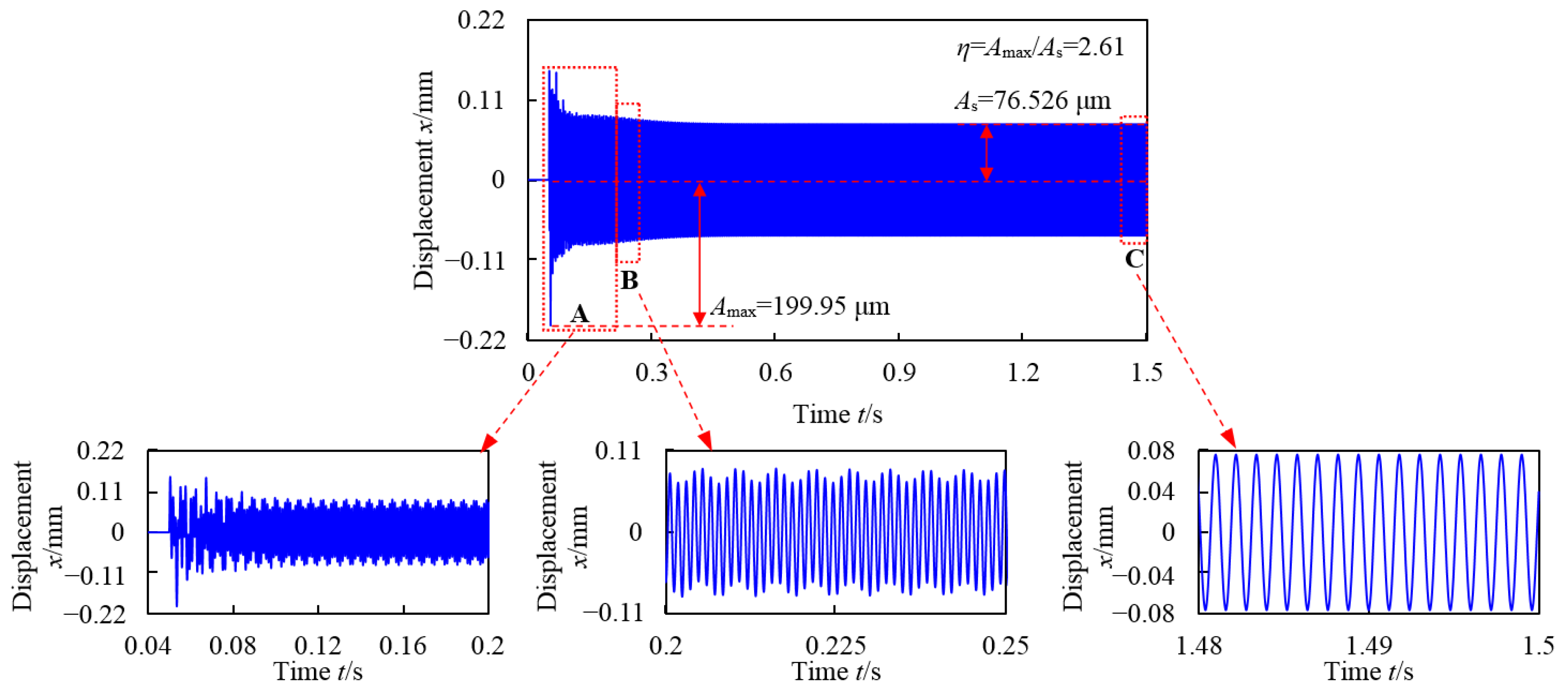
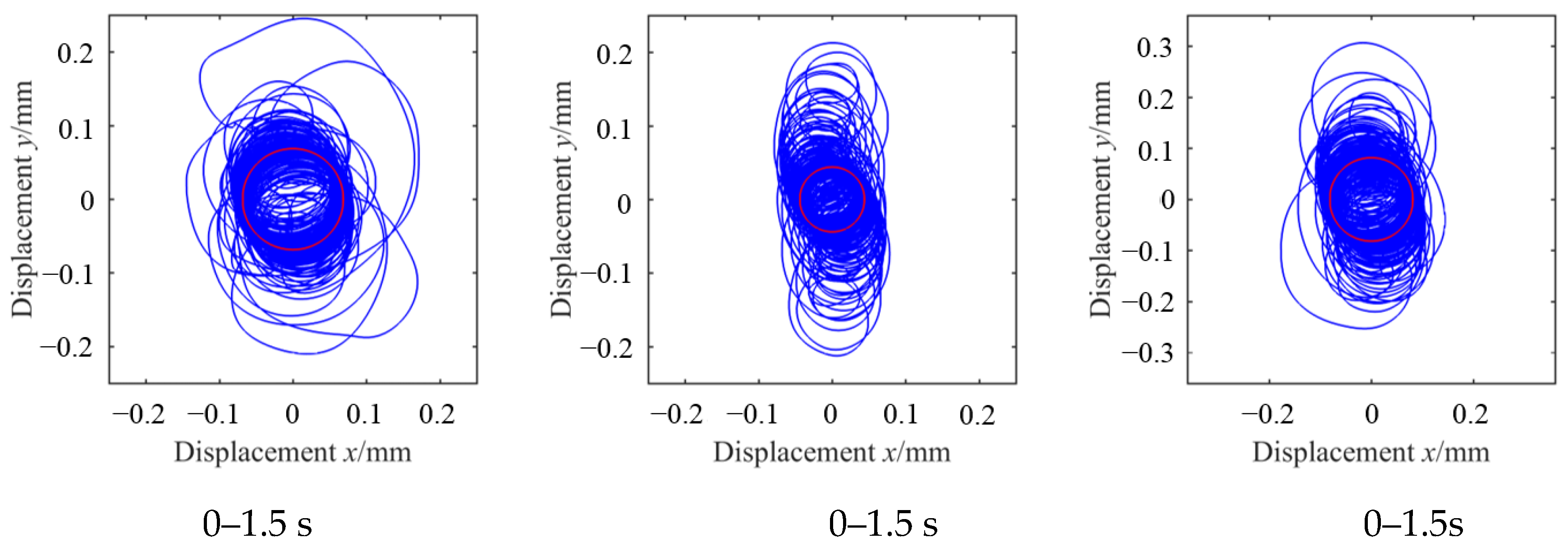


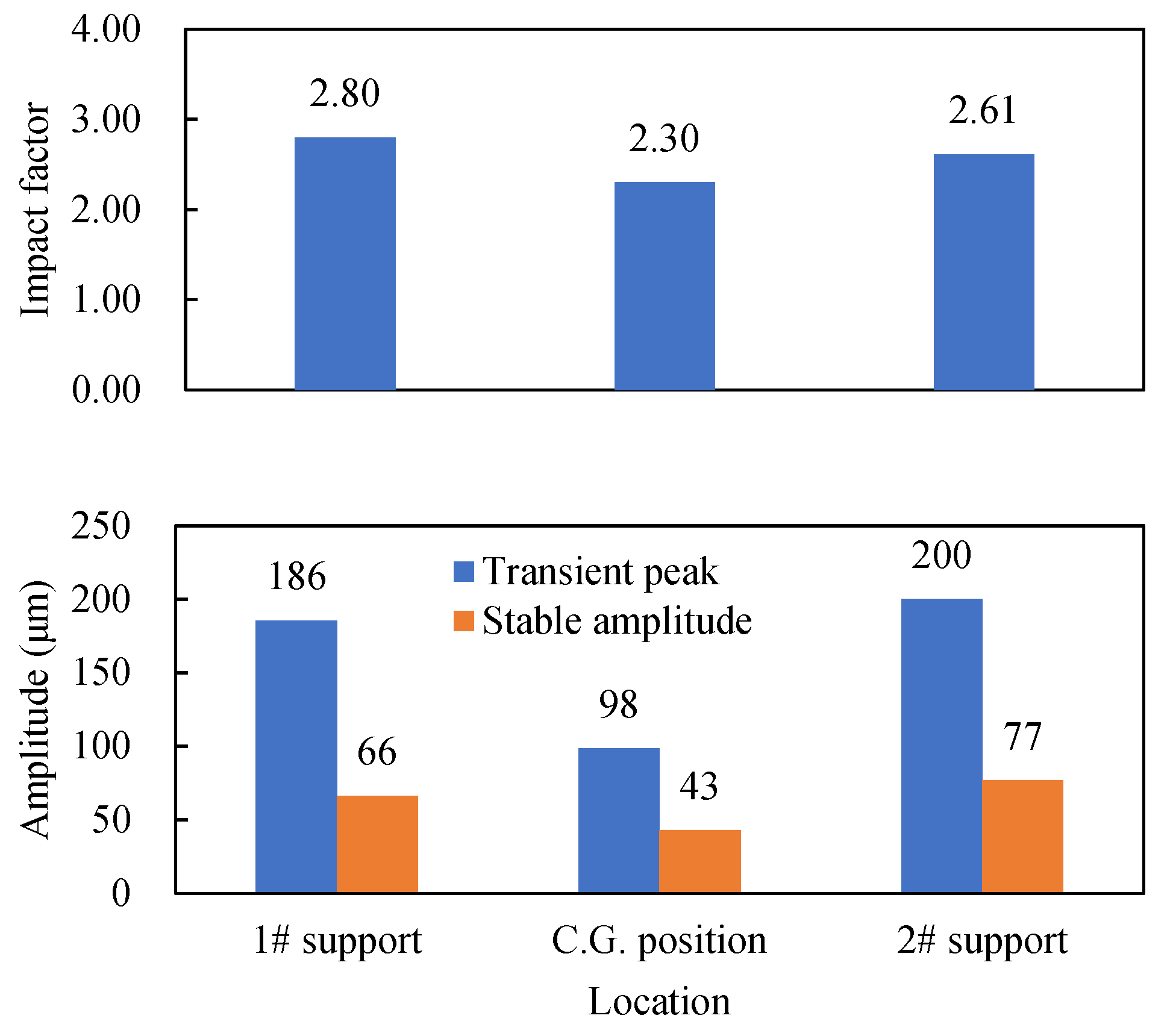
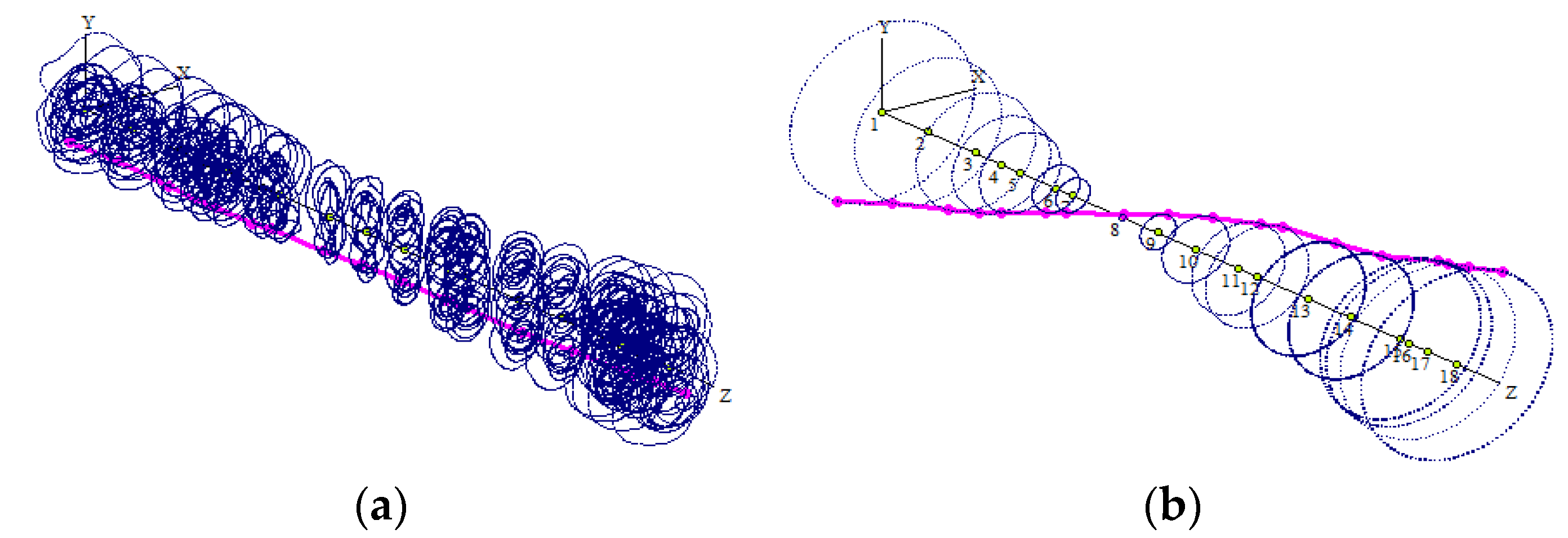


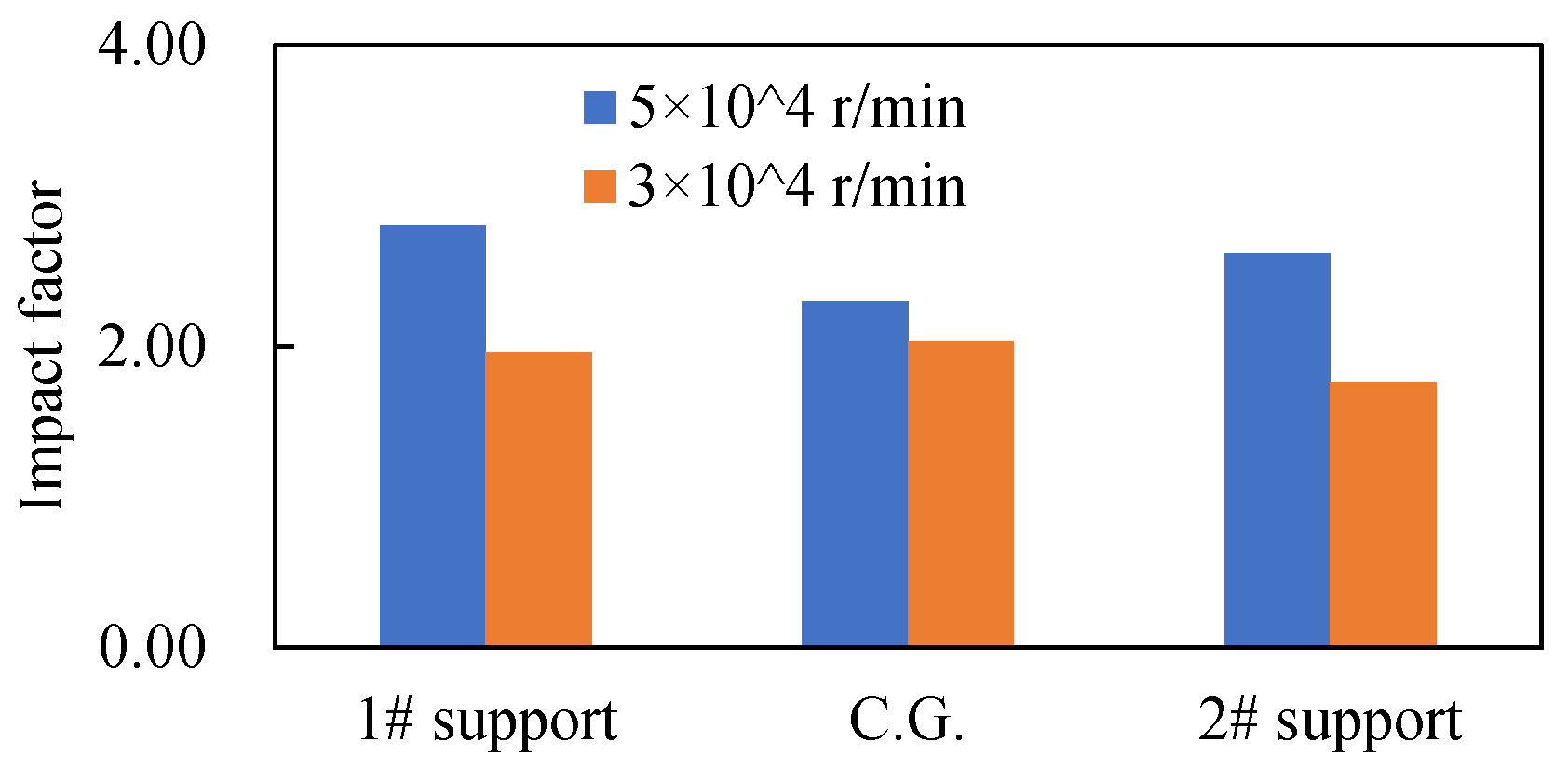

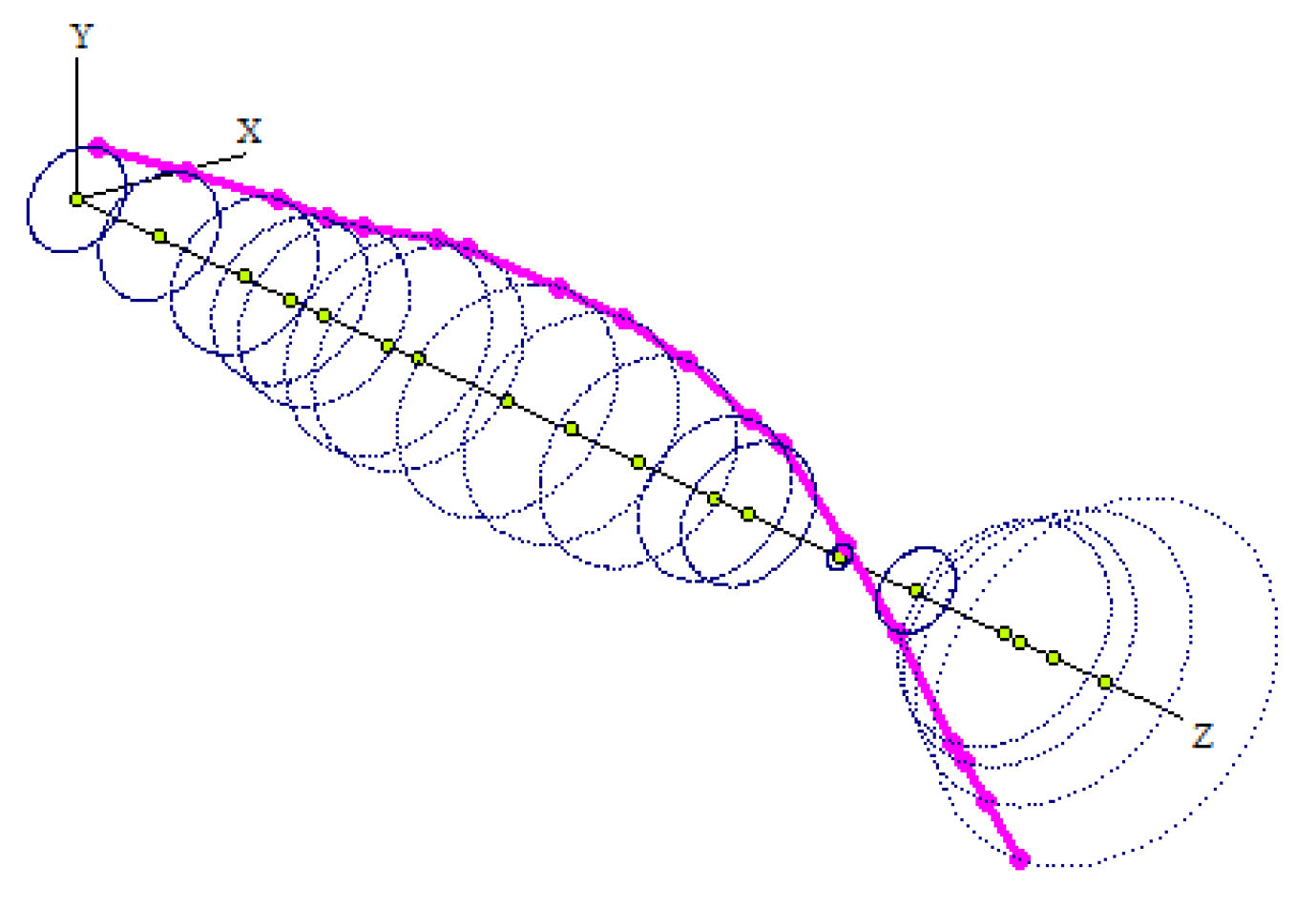


| No. | Simulation Result (Hz) | Experimental Value (Hz) | Relative Error (%) |
|---|---|---|---|
| 1st order | 413 | 402 | 2.74 |
| 2nd order | 1164 | 1146 | 1.57 |
| 3rd order | 5839 | 5768 | 1.23 |
| Parameter | Blade Loss Mass (kg) | Radius of Blade Mass Center (mm) |
|---|---|---|
| Value | 8.46 × 10−3 | 97.77 |
Publisher’s Note: MDPI stays neutral with regard to jurisdictional claims in published maps and institutional affiliations. |
© 2021 by the authors. Licensee MDPI, Basel, Switzerland. This article is an open access article distributed under the terms and conditions of the Creative Commons Attribution (CC BY) license (https://creativecommons.org/licenses/by/4.0/).
Share and Cite
Wang, L.; Yin, Y.; Wang, A.; Heng, X.; Jin, M. Dynamic Modeling and Vibration Characteristics for a High-Speed Aero-Engine Rotor with Blade Off. Appl. Sci. 2021, 11, 9674. https://doi.org/10.3390/app11209674
Wang L, Yin Y, Wang A, Heng X, Jin M. Dynamic Modeling and Vibration Characteristics for a High-Speed Aero-Engine Rotor with Blade Off. Applied Sciences. 2021; 11(20):9674. https://doi.org/10.3390/app11209674
Chicago/Turabian StyleWang, Longkai, Yijun Yin, Ailun Wang, Xing Heng, and Miao Jin. 2021. "Dynamic Modeling and Vibration Characteristics for a High-Speed Aero-Engine Rotor with Blade Off" Applied Sciences 11, no. 20: 9674. https://doi.org/10.3390/app11209674
APA StyleWang, L., Yin, Y., Wang, A., Heng, X., & Jin, M. (2021). Dynamic Modeling and Vibration Characteristics for a High-Speed Aero-Engine Rotor with Blade Off. Applied Sciences, 11(20), 9674. https://doi.org/10.3390/app11209674






